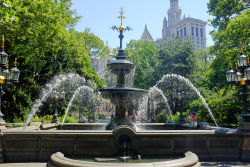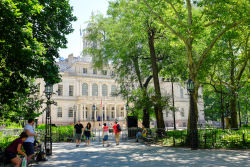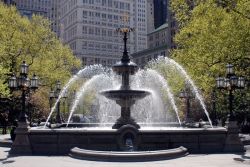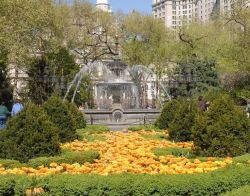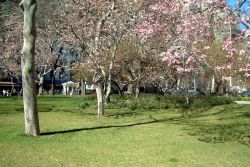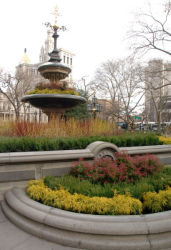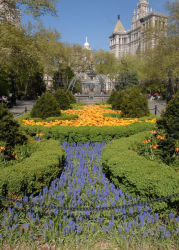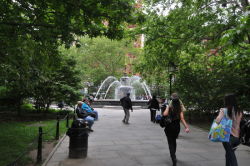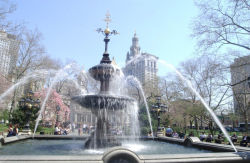City Hall Park
The Daily Plant : Tuesday, September 10, 2002
ASK PROFESSOR GINKGO: THE FOUNTAINS OF NEW YORK
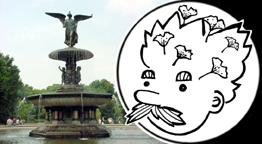
Dear Professor Ginkgo:
I have two questions about fountains. My first question is whether our parks' fountains could have been revived with flowing water during this Stage I Drought Emergency with water that circulates within the fountain?
My second question is about Bethesda Fountain. I've heard two different reasons for why it was constructed: first, that it was installed as a celebration of the completion of the Croton Aqueduct and second, that the fountain was Olmsted's tribute to the Union dead from the Civil War. Do you know which one is right?
Thank you for your questions. In answer to your first question, quite a few of the city's 55 or so fountains recirculate water. These fountains include Bethesda Fountain, the fountain at City Hall Park, and the fountain at Columbus Circle. The others-called waste-water fountains-waste a relatively small amount of water but waste more water than recirculating fountains. Although recirculating fountains waste virtually no water, Parks still shuts them off during drought conditions. One of the primary reasons for this is to remind people that we are in a drought. Pools and playground spray showers remain and provide much-needed relief from the heat, but fountains-although they are refreshing to look at-are not necessary. When people see an empty fountain, they are reminded to be more considerate about water usage. Added to this is the fact that recirculating fountains do indeed lose a certain amount of water each day to evaporation, spillage, and leakage.
All of Parks' fountains are shut off during the winter (although there are a few non-Parks city fountains that remain on) and are turned on in mid-spring. This year, because Parks predicted the drought early on, the fountains were never turned on. The last time Parks shut down its fountains was during the city's last major drought in 1989.
You will find it interesting to know that, according to the Borough Chiefs of Operations, it would take about 1.3 million gallons to start up all of Parks' fountains citywide. The amount of water required to replenish the fountains as a result of evaporation, leakage, spillage would be about 40,000 gallons/day. And all of these fountains are, just like your sink spigot, connected to the city's drinking water supply. The cities of the future will one day operate on gray water supplies-in which there will be several grades of water, and drinking water will only be delivered to where it is necessary. Parks has already taken a step in this direction by installing a spray water system at Seward Park. Spearheaded by Parks' Olmsted and Five-Boro divisions, this site will be used as a model citywide.
In answer to your second question, the Angel of the Waters fountain (or Bethesda Fountain, as it's commonly called), was built in celebration of the completed 1842 Croton Aqueduct which delivered fresh water from Westchester throughout the city. (Incidentally, the water traveled across the city's oldest bridge, the High Bridge, from the Bronx into Manhattan. Parks' Manhattan Borough office and Planning office are coordinating efforts to build support to restore this bridge.) The fountain was created by sculptor Emma Stebbins (1815-1882), who was the first woman to be awarded the commission for a major pubic work in New York City. Although the fountain was not dedicated until 1873, Stebbins began work on the statue in Rome in 1861 (at the start of the Civil War) and she completed it in 1868. The brochure at the opening quoted a verse from the Gospel of St. John 5:2-4 that read, "Now there is at Jerusalem by the sheep market a pool, which is called&Bethesda&whoever then first after the troubling of the waters stepped in was made whole of whatsoever disease he had." Indeed, the Croton Aqueduct brought potable drinking water to the city and helped bring an end to many diseases that had plagued the city for years. The lily in the angel's hand represents purity, and the four figures below her signify Peace, Health, Purity, and Temperance.
I believe your confusion has arisen from a comment made by the playwright Tony Kushner in Ric Burn's New York: A Documentary Film. I have been told that Mr. Kushner incorrectly suggested this alternate explanation of the Angel.
If you have parks trivia question, email me at Professor.Ginkgo@parks.nyc.gov.
THIRTEEN YEARS AGO IN THE PLANT
(Tuesday, September 19, 2002)
NOAH'S ART OPENS AMID FLOOD OF ENTHUSIASM
It could have been a Cecil B. DeMille set for "The Story of Noah." As if on cue, rain poured from the heavens and a menagerie of sculpted birds, fish, bears, tigers, and other species roamed the southern end of Central Park.
Today's stormy weather provided the perfect backdrop for the opening of "Noah's Art," Central Park's first free outdoor exhibit of animal sculptures. Organized by Park's Art & Antiquities division. Noah's Art features contemporary sculptures of animals, created by a wide variety of well-established and emerging artists.
QUOTATION FOR THE DAY
''Look not mournfully into the past. It comes not back again. Wisely improve the present. It is thine. Go forth to meet the shadowy future, without fear.''
Henry Wadsworth Longfellow
Check out your park's Vital Signs
Clean & Safe
Green & Resilient
Empowered & Engaged Users
Share your feedback or learn more about how this park is part of a
Vital Park System

